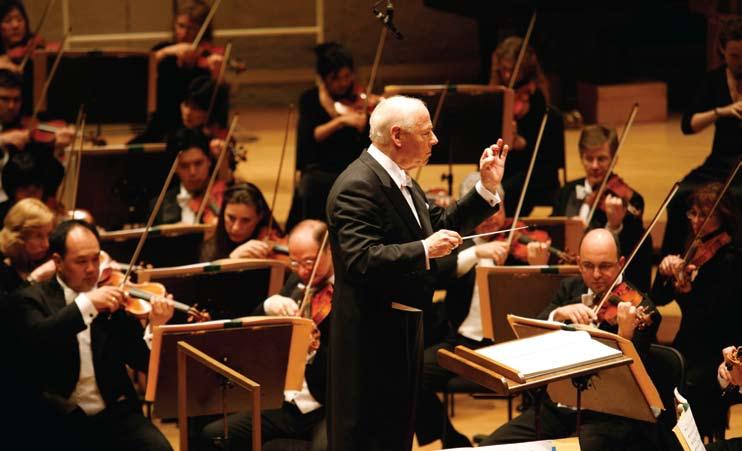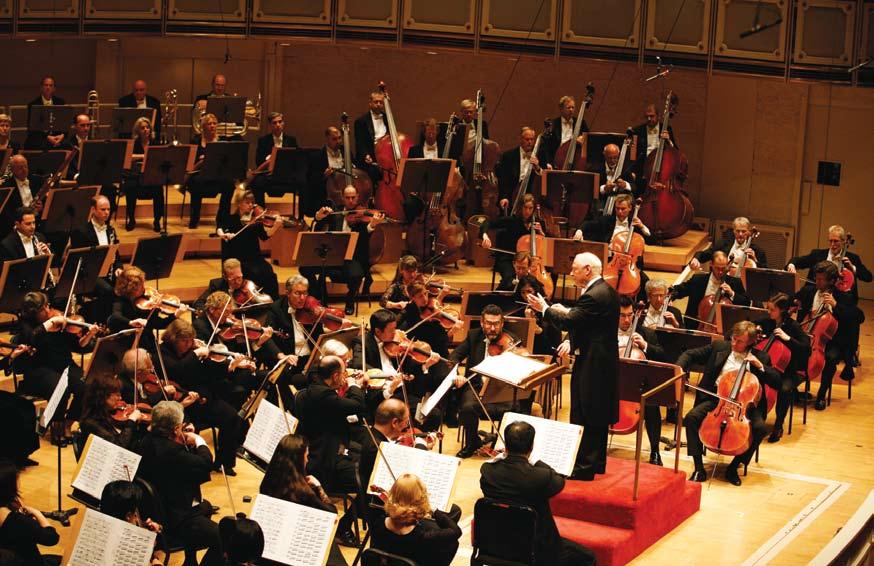

海廷克 Bernard Haitink
首席指揮
Principal Conductor
荷蘭阿姆斯特丹出生,當今音樂界首 屈一指的指揮家海廷克,縱橫世界各 地,出任指揮逾半世紀。他曾領導許 多世界著名樂團,包括在阿姆斯特丹 皇家音樂廳樂團擔任音樂總監達25 年。此外,他也曾出任德累斯頓管弦 樂團、高文花園皇家歌劇院、格蘭特 堡節日歌劇院及倫敦愛樂樂團等樂團 的音樂總監。海廷克現任阿姆斯特丹 皇家音樂廳樂團桂冠指揮和波士頓交 響樂團榮休指揮,經常為柏林愛樂樂 團、維也納愛樂樂團、巴伐利亞廣播 交響樂團、倫敦交響樂團等世界頂尖 樂隊擔任客席指揮。2006年起海廷克 擔任芝加哥交響樂團首席指揮。
2008/09年樂季,海廷克在芝加哥駐 團三周,帶領芝加哥交響樂團演出馬 勒的第六交響曲及特內奇《芝加哥遺 址》的世界首演,並和芝加哥交響樂 團合唱團合作,演出普朗克的《榮
耀》和拉威爾的《達芙妮和克洛埃》。
2008年盧塞恩復活節音樂節上,他與 歐洲室樂團合作,演出一系列貝多芬 交響樂、協奏曲和序曲。
海廷克曾經帶領芝加哥交響樂團錄製 馬勒的第三及第六交響曲,以及布魯 克納的第七交響曲。又曾與阿姆斯特 丹皇家音樂廳樂團錄製馬勒、布魯克 納和舒曼的交響樂全集,與柏林愛樂 樂團、維也納愛樂樂團及波士頓交響 樂團也合作推出過多張唱片。他最近 與倫敦交響樂團灌錄了布拉姆斯交響 樂全集和貝多芬交響樂全集。海廷克 推出的唱片還包括與皇家歌劇院、格 蘭特堡歌劇節、巴伐利亞廣播交響樂 團及德累斯頓管弦樂團合作的歌劇錄

With an international conducting career that has spanned more than five decades, Amsterdam-born Bernard Haitink is one of today’s most celebrated conductors. Appointed Principal Conductor of the Chicago Symphony Orchestra (CSO) in 2006, he has led many of the world's major orchestras, including more than 25 years at the helm of the Royal Concertgebouw as its Music Director. In addition, Haitink has previously held posts as Music Director of the Dresden Staatskapelle, Royal Opera, Covent Garden, Glyndebourne Festival Opera, and the London Philharmonic. He is Conductor Laureate of the Royal Concertgebouw Orchestra and Conductor Emeritus of the Boston Symphony Orchestra. He continues to make frequent guest appearances with the Berlin Philharmonic, Vienna Philharmonic, Bavarian Radio Orchestra, London Symphony, and other leading orchestras around the world.
Haitink’s 2008/09 season in Chicago began with a three-week residency in October and November, during which he led the CSO in concerts including Mahler's Symphony No. 6, the world premiere performances of Mark-Anthony Turnage's Chicago Remains, and both Poulenc's Gloria and Ravel’s Daphnis and Chloe with the Chicago Symphony Chorus. At the Lucerne Easter Festival 2008 he began a cycle of all of Beethoven's symphonies, concertos, and overtures with the Chamber Orchestra of Europe.
With the CSO, Haitink has recorded Mahler’s Symphony Nos. 3 and 6 and Bruckner's Symphony No. 7. He also has recorded the complete cycles of the symphonies of Mahler, Bruckner, and Schumann with the Concertgebouw and numerous recordings with the Berlin and Vienna Philharmonics as well as the Boston Symphony Orchestra. With the London Symphony, his most recent recordings are the complete Brahms and Beethoven symphonies. In addition, his discography includes many opera recordings with the Royal Opera and Glyndebourne, as well as with the Bavarian


音。海廷克與皇家歌劇院交響樂團、 合唱團和演唱家合作錄製的亞納切克 的歌劇《耶奴法》,榮獲2004年格林 美最佳歌劇唱片獎。
海廷克對音樂的貢獻,使他獲得多個 國際榮譽與獎項,包括英國的榮譽爵 士和榮譽勳爵士,荷蘭的奧瑞治-拿騷 皇室勳章,以及2007年《美國音樂》 年度音樂家大獎。

Radio Orchestra and Dresden Staatskapelle. Haitink's recording of Janáček’s Jenůfa with the orchestra, chorus, and soloists of the Royal Opera received a Grammy Award for Best Opera Recording in 2004.
Haitink has received many international awards in recognition of his services to music, including both an honorary knighthood and the Companion of Honour in the UK and the House Order of Orange-Nassau in the Netherlands. He was named Musical America’s 2007 Musician of the Year.

2009年2月6日(星期五)
6.2.2009 (Friday)

莫扎特 (1756-1791)
— 中場休息 —
李察.史特勞斯 (1864-1949)
C大調第四十一交響曲,K 551(朱庇特)
活潑的快板
如歌的行板
小步舞曲:小快板
甚快板
《英雄的一生》,作品 40
小提琴 陳慕融
Wolfgang Amadeus Mozart (1756-1791) Symphony No. 41 in C, K 551 (Jupiter)
Allegro vivace
Andante cantabile
Menuetto: Allegretto
Molto allegro
— Interval —
Richard Strauss (1864-1949)
演出長約1小時30分鐘,包括一節中場休息
Ein Heldenleben, Op. 40
violin Robert Chen
Running time: approximately 1 hour and 30 minutes with one interval
莫扎特
C大調第四十一交響曲,K 551(朱庇特)

莫扎特於1788年8月10日完成C大調交響曲,從沒想過這會是他最後一首交響 曲,也從沒用過「朱庇特」一名。根據英國出版商文森特.諾威羅的日記所
述,莫扎特兒子法蘭斯.薩弗說,是約翰.彼得.薩羅蒙(倫敦知名的音樂會 主辦人)主張以法力最強的羅馬主神名字作為此曲別稱。「朱庇特」一名首次 在印刷品上出現,是1819年10月20日愛丁堡一場演出的相關刊物裏;克萊曼
蒂改編的鋼琴版也大受歡迎,1823年出版時封面上寫着「莫扎特的著名交響曲 『朱庇特』」,還畫上朱庇特坐在翻騰的雲霧上,充滿帝王風範。
早在克萊曼蒂讓無數充滿熱誠的業餘鋼琴手認識此曲以前,這首壯麗的C大調交 響曲早已名滿天下:海頓就對此曲大為欣賞(無獨有偶,也是因為同一位薩羅 蒙先生,海頓才會有他的最後12首交響曲)。
薩羅蒙之所以選中「朱庇特」作為別稱,大概是因為樂曲堂皇高貴的第一樂 章。第一樂章既運用了嘹亮的小號和鼓,開端幾小節又用上莊嚴的附點節奏 (而且十八世紀禮儀音樂多以C大調寫成),但這個奏鳴曲式樂章同時也輕盈佻 皮:再現部在錯誤的調性(次屬音)開始,這是內行人才懂的玩笑,此外又引 用了一首輕鬆愉快的詠嘆調新作(原曲是男低音向情竇初開的戀人唱出「親愛 的龐比奧,你有點幼稚。去見見世面吧」。歌詞可能出自達龐迪手筆)。這個樂 章像《唐.喬望尼》一樣,具有莫扎特「莊諧並重」的特色。
第一樂章猶如烈日當空,〈行板〉則剛好相反,弦樂加上弱音器來演奏,盡顯常 常潛藏在莫扎特音樂裏的陰暗面。沉思、渴望與悲傷,如《魔笛》裏帕米娜的 著名詠嘆調一般令人肝腸寸斷;以大調寫成則更顯得不落俗套。小步舞曲與中 段雖然以質樸的傳統舞曲形式寫成,但無論音樂上、情感上都異常豐富多彩, 毫不簡單。
第四樂章結尾的賦格曲樂段足與十八世紀所有單樂章樂曲齊名。樂章開始時 十分簡單:do-re-fa-mi主題最初其貌不揚,後來卻蛻變成古典對位法的巔峰 之作。五個主題經過交代、發展、重申,最後在精采絕倫的尾聲以不同方式 結合起來(有時還上下顛倒),完美的對位技巧令人目不暇給。憑着這個兩分 鐘的樂段,莫扎特把整首交響曲的重心由開端移至結尾,為貝多芬、布拉姆 斯和後世多位作曲家所仿效(事實上,這些作曲家還在其他方面受莫扎特影 響)。莫扎特固然無法料到這就是他最後一首交響曲,但要為他的成就劃上完美 壯觀的句號、並為後世作曲家指出新路向,也沒有比「朱庇特」更適合的了。

Richard Strauss
Ein Heldenleben, Op. 40

In 1898, after dedicating music of lasting brilliance to heroes taken from the pages of Shakespeare, Nietzsche, and Cervantes, and to two great legendary characters—Don Juan and Till Eulenspiegel—Richard Strauss could think of no other subject more suitable than himself. At the top of his last great tone poem he wrote Ein Heldenleben (A Hero’s Life), leaving little doubt of the title character’s identity.
Those who knew Strauss thought him an unlikely hero. There was nothing about him— apart from his own dazzling music—to compare with the bold and fearless character who throws open the first page of this score and then holds our attention for one enormous paragraph of music—the 116 measures of non-stop orchestral exhibitionism that Strauss labels “The Hero”. The moment of silence that follows is broken by the squabbling of the woodwinds, introducing “The Hero’s Adversaries”. This is Strauss’s depiction of his critics, and it is rendered with such hatred (Strauss requests “snarling” oboes and “hissing” cymbals) that one would think he had never received a good review in his life.
Next we meet Strauss’s wife, Pauline Strauss de Ahna, an accomplished soprano who sings here with the voice of a solo violin. Strauss met Pauline de Ahna in 1887, when his uncle suggested he give lessons to the neighbours’ daughter. Pauline was a complex woman—wildly impetuous and often fractious and stubborn—but Strauss quickly realized he couldn’t live without her. She gave him advice and encouragement, and she was the only critic who mattered to him. As Strauss admitted, Pauline was a “very complicated” subject to portray, “different each minute from what she was a minute earlier”. “The Hero’s Companion”, as Strauss calls this mercurial section, is a full-length portrait, and it is not always complimentary. Nevertheless, theirs was a great love match, and love music soon overpowers her voice and encompasses the entire orchestra. The hero’s adversaries again raise their sharp voices, and he prepares to attack. “The Battle Scene” is noisy and thrillingly chaotic for a very long stretch. Gradually the hero is strengthened by thoughts of love and he rises above his adversaries. A broad ascent to victory is marked by the return of the opening theme, now at full cry. At the climax, the horns let loose with the great, vaulting signature tune from Don Juan, prompting the appearance of other themes from Don Juan and Also sprach Zarathustra before the music gradually fades.
In a quiet daydream (a gently swaying barcarole), Strauss recalls music from all his previous tone poems as well as many of his songs, even the failed Guntram. These are “The Hero’s Works of Peace”. The critics reappear briefly; Strauss rises up against them in one last tirade. The final section is labelled “The Hero’s Escape from the World and Fulfilment”. The music now slips into a simple pastorale, with an English horn calling out over a quiet drum tap. The violins repeatedly hint at a new theme, which finally rises from total silence—a melody so noble and disarming that we do not recognize it as the same sequence of notes first uttered rather ineloquently by Pauline. It is one of Strauss’s greatest themes, all the more moving for coming so near the end, like a grand benediction. There is one last, disruptive assault from the critics, and then the loving voice of Pauline, obviously quite undone by some of her husband’s most sublime music.
Adapted from programme notes by Phillip Huscher, the Chicago Symphony Orchestra Programme Annotator.
A小調第六交響曲

「第六交響曲」是馬勒最遲登陸美國的交響曲,1947年12月才在美國首演,距作曲家 親自指揮的世界首演超過41年。芝加哥交響樂團更遲至1968年才演出馬勒第六,而馬 勒其他交響曲,包括未完成的「第十」卻早已演遍。馬勒交響曲的典型遭遇是:由作 曲家親自指揮的首演困難重重,遭觀眾和樂評誤解和唾棄,往後數十年被大樂團和名 指揮忽視;但即使如此,第六仍是最被忽視的一首。
馬勒妻子艾瑪說第六是馬勒最個人的作品,而馬勒則是第一個料到樂曲會得到什麼待 遇的人。樂曲完成後,馬勒給理查.史帕赫特寫信道:「我的第六會留下很多謎團, 只有後世那些已經吸收並徹底了解我前五首交響曲的人才能解開。」即使在馬勒生 前,第六也似乎成功無望:除了在1906及1907年由馬勒親自指揮的寥寥數次演出外, 在馬勒1911年離世前顯然再也沒有演出過。
馬勒事業上最大的悲劇不在於他默默無聞、無名無利──相反,他是樂壇名人,是 當時的名指揮家之一──而在於他認為自己真正的終生事業失敗了,落得飲恨而 終。1911年他過世時完全沒想過第六還有演出的機會,也肯定不會知道有人會欣賞他 的音樂。
馬勒差不多所有交響曲都是在暑休時動筆,第六也不例外。馬勒在沃爾特湖畔的麥爾 尼格有幢別墅;1903年6月,他與艾瑪和年幼的女兒瑪利亞到那裏度假;待到第三個 夏季,馬勒才得以在詳和氣氛裏作曲。
那個夏天,馬勒寫了第六兩個樂章。艾瑪憶述:「第一樂章草稿完成後,他自樹林走 過來,告訴我曲中有個代表我的主題:『我不知道寫得像不像,但你都得忍受。』」
身為維也納歌劇院靈魂人物的馬勒,熬過又一忙亂的樂季後,翌年夏季帶着艾瑪、瑪 利亞,還有剛出生的女兒安娜,再度前往麥爾尼格度假。這是他一生中創作最豐富的 時候:完成了第六,開始「第七」,又寫作了《亡兒之歌》最後一首。本來是舉家度 假的安寧日子,馬勒竟然寫作這種歌曲,很令艾瑪心緒不寧。她也在第六的諧謔曲看 到一團討厭的烏雲:「他在第三樂章刻畫了兩個小孩不規則的玩樂聲,在沙上搖搖欲 墜地走着走着。孩子的聲音越來越悲傷,最後在抽噎聲逐漸消失。很不祥。」
可是,最不祥的莫過於終樂章。艾瑪寫道:「他在終樂章寫自己、寫自己倒下;或 者,就像他後來自言,是他的英雄:『命運在英雄身上重重地捶了三下,最後一下把 他擊倒,像大樹一樣倒下。』那是他的話。」這首陰暗、悲哀的作品令艾瑪十分憂 慮,馬勒更一度想把此曲稱為《悲劇》交響曲,她害怕丈夫寫這樣的曲子,會葬送了 兩人最快樂的光陰。
回顧第六完成以後馬勒所經歷的種種不幸,很難不令人拿來與曲中的三下重擊相對 照。1907年,輿論壓力、紛爭、愈演愈烈的反猶太主義,迫使馬勒從維也納歌劇院的 高職上退下來;同年夏季,馬勒一家人到達麥爾尼格度假後不久,長女瑪利亞染上猩 紅熱,不出幾周就死了。馬勒還未來得及自悲傷中復原過來,就被診斷出有嚴重心臟 病──套用他自己的話,那就是最後一擊,使他像大樹一樣倒下。
不論是預言、玩命還是純粹音樂,第六也是馬勒惟一真正哀傷的作品──惟一最終沒 有得勝、曲中無名英雄最終徹底被擊倒的一首。他其他作品都不會像這首一樣堅持一 馬勒


her husband, in writing this music, had altered forever the happiest time of their life.
In reviewing the sad events that followed the completion of this symphony, it is difficult not to admit a parallel with the three blows of fate Mahler had etched in music. In 1907, bad press, controversy and rising anti-Semitism forced Mahler from his prestigious post as head of the Vienna Opera. That summer, soon after the family retreated to Maiernigg, Maria, the older daughter, fell ill with scarlet fever and died within weeks. Before Mahler could begin to recover from this shock, his serious heart condition was diagnosed—the final blow that would ultimately fell him as a tree is felled.
Whether it was prophesy, tempting fate, or simply music, the Symphony No. 6 is Mahler’s only tragic work in the truest sense—the only one that fails to rise to victory, the only one in which the unnamed hero is utterly defeated. No other work so unrelentingly asserts a single key: three of the four movements are planted in A minor, and, although Mahler is known for the way his symphonies end in keys never suggested by their openings, here he seems unable to escape the grim pull of A minor, and the final page ends with the same low A with which the first movement opens.
The work begins with military music—not the leaden funeral marches of the Second or Fifth Symphonies, but a quick, driven march—soldiers’ music remembered from his childhood. There is the recurring sound of drums; Mahler calls for a larger contingent of drums and percussion here than in any other symphony. The march ends with a sound that becomes the symphony’s motto: a brilliant major triad that turns to minor while the drums pound the drillmaster’s rhythm. After a quiet wind chorale, the impetuous “Alma” theme takes wing in the violins—a “great soaring theme”, as Alma described it—and each time it returns throughout the movement, it is slightly changed, as elusive and bewitching as Alma herself.
Later, when the music calms, we hear from the distance the sound of cowbells. Mahler added a footnote to the score suggesting that “the cowbells should be played with discretion—so as to produce a realistic impression of a grazing herd of cattle, coming from a distance, alternately singly or in groups, in sounds of high and low pitch. Special emphasis is laid on the fact that this technical remark admits of no programmatic interpretation”. Later, however, Mahler did say that the cowbells “are the last earthly sounds heard from the valley far below by the departing spirit on the mountain top”.
Mahler originally planned to follow the great sonata-form first movement with the Scherzo, placing the calm Andante before the vast finale. But at the time of the symphony’s premiere, in Essen in May 1906, he reversed the two inner movements. The first published score, however, kept the Scherzo before the Andante —though with a note about Mahler’s second thoughts—and it is this sequence that most conductors today, Bernard Haitink included, prefer, despite Mahler’s own apparent change of heart.
Mahler may have contemplated delaying the Scherzo because it is so closely related to the mood of the first movement. Certainly the opening, with its driving A minor rhythm, sounds as if it belongs to the previous music. Two gentle trios interrupt the Scherzo, both rocked by the totterings of little Anna and Maria, one in F and one in D (the keys, not coincidentally, in which the exposition and development of the first movement had come to rest). There is a great, prophetic orchestral scream—a premonition of the finale—just before the end, and then the last zigzagging of the two children.

The Andante, set in E-flat major, the most remote key from A minor in the tonal system, does indeed seem to come from another world, although it is still touched by the tragic tone of the previous movement. The cowbells sound from the valleys below, and the spirit of the Kindertotenlieder hovers.
The finale is, in every sense, one of the biggest movements in Mahler’s output, building slowly and masterfully through three massive climaxes, each crowned by a hammer blow. The music is richly varied and even quotes passages from the earlier movements. Mahler calls for a great array of instruments, including, of course, the sledge hammer.
The music is deadly serious. It begins with an echo of the scream from the end of the Scherzo —an unsettling explosion that unleashes exotic sounds even by Mahler’s own standards. From there, Mahler moves through music of sweeping complexity—his command of counterpoint is particularly impressive—toward the first of the hammer blows, a climax that lands in unexpected harmonic territory as the hammer falls ƒƒƒ. Twice more, through vast and meticulously charted stretches, Mahler approaches exultation. And again, the hammer falls. At the end, nothing is left but a few threads of sound, one last horrible lunge and the deathly sound of A minor.
At some point after the first performances, Mahler decided to omit the third hammer blow—the one that fells the hero. (At this performance, Bernard Haitink omits it as well.) But Mahler could do nothing about the blows of fate that would soon befall him, and nothing could stop the heart condition that was already weakening him and shortly would kill him.
Adapted from programme notes by Phillip Huscher, the Chicago Symphony Orchestra Programme Annotator.

芝加哥交響樂團
Chicago Symphony Orchestra
首席指揮 Principal Conductor
雷根斯坦榮休指揮 Helen Regenstein Conductor Emeritus
合唱總監 Chorus Director
駐團作曲家 Mead Composers-in-Residence
小提琴 Violins
Robert Chen
Concertmaster
The Louis C. Sudler Chair, endowed by an anonymous benefactor
David Taylor
Yuan-Qing Yu
Assistant Concertmasters *
Cornelius Chiu
Nathan Cole
Alison Dalton
Kozue Funakoshi
Russell Hershow
Qing Hou
Nisanne Howell †
Blair Milton
Paul Phillips, Jr.
Sando Shia
Susan Synnestvedt
Rong-Yan Tang
Akiko Tarumoto
Baird Dodge
Principal
The Marshall and Arlene
Bennett Family Foundation Chair
Albert Igolnikov
Assistant Principal
Lei Hou
Ni Mei
Arnold Brostoff
Fox Fehling
Hermine Gagné
Rachel Goldstein
Mihaela Ionescu
Melanie Kupchynsky

Wendy Koons Meir †
Aiko Noda
Joyce Noh
Nancy Park
Ronald Satkiewicz
Florence Schwartz-Lee
Jennie Wagner
中提琴 Violas
Charles Pikler
Principal
The Prince Charitable Trusts Chair
Li-Kuo Chang
Assistant Principal
The Louise H. Benton Wagner Chair
John Bartholomew
Catherine Brubaker §
Karen Dirks
Lee Lane
Diane Mues
Lawrence Neuman †
Yukiko Ogura
Daniel Orbach
Max Raimi
Thomas Wright
大提琴 Cellos
John Sharp
Principal
The Eloise W. Martin Chair
Kenneth Olsen
Assistant Principal
The Adele Gidwitz Chair
Philip Blum
Loren Brown
Bernard Haitink
Pierre Boulez
Duain Wolfe
Osvaldo Golijov
Mark-Anthony Turnage
Richard Hirschl
Katinka Kleijn
Jonathan Pegis
David Sanders
Gary Stucka
Brant Taylor
低音大提琴 Basses
Joseph Guastafeste
Principal
The David and Mary Winton
Green Chair
Daniel Armstrong
Roger Cline
Joseph DiBello
Michael Hovnanian
Robert Kassinger
Mark Kraemer
Stephen Lester
Bradley Opland
豎琴 Harps
Sarah Bullen §
Principal
Lynne Turner
長笛 Flutes
Mathieu Dufour
Principal
Richard Graef §
Assistant Principal
Louise Dixon †
Jennifer Gunn
短笛 Piccolo
Jennifer Gunn
杜卡 (1865-1935)
加比埃利 (約1554-57-1612)
華格納 (1813-1883)

達爾 (1912-1970)
— 中場休息 —
狄信湯瑪士 (1944- )
勞里特森 (1943- )
魏爾 (1900-1950)
2009年2月8日(星期日)
演出長約1小時40分鐘,包括一節中場休息
號曲,選自《佩里》
《八聲部七音歌曲》
《紐倫堡的名歌手》第三幕選段 (馬克.賴德諾爾編曲)
序曲
五重唱
名歌手進場
得獎曲
銅管樂音樂
聖咏幻想曲《基督受死亡捆綁》
間奏曲
賦格曲
《街頭之歌》
《無限神秘》
《三毛錢歌劇》組曲 (戴維.珀澤編曲)
序曲
小刀老麥民謠
而不是之歌
悠閒生活民謠
寳莉之歌
探戈-民謠
大炮之歌
三毛錢終曲


首六到十六聲部的讚歌。這次演出的 《八聲部七音歌曲》,是以「第七 音」,即以G音譜寫,其舞動的韻律, 和弦的織體以及分部的建構,都流露 着16世紀末歌曲的風格。
華格納
《紐倫堡的名歌手》第三幕選段 (馬克.賴德諾爾編曲)
《紐倫堡的名歌手》的故事發生於十 六世紀德國紐倫堡的仲夏節歌唱大 賽。金匠波格納宣佈將漂亮的女兒伊 娃嫁給仲夏節歌唱大賽的優勝者。年 輕騎士華爾特與伊娃早已相戀,雖然 自已不是名歌手協會的會員,但誓要 贏得比賽迎娶伊娃。鎮書記貝克梅瑟 也參加了歌唱比賽,指華爾特寫的歌 曲不符合名歌手協會的規則,企圖取 消他的資格,不過最終華爾特還是獲 准參賽。華爾特和伊娃把他們相戀的 事告訴了聰明的鞋匠名歌手薩克斯。
雖然薩克斯也愛上了伊娃,但仍視他 們為朋友,為他們出謀獻策。在薩克 斯的襄助下,華爾特學會了唱歌寫 詩,其作品的音樂表現手法,更為花 巧的名歌手音樂帶來了清新的風格。
貝克梅瑟盜取了華爾特的詩歌,卻譜 上愚笨的樂曲,在歌唱比賽上出醜。
薩克斯邀請華爾特演繹這首詩歌,結 果華爾特在歌唱比賽中勝出。
《紐倫堡的名歌手》是齣溫馨喜劇, 卻包含了內省的元素,主要由深思慎 密的薩克斯帶出。第三幕深沉的序曲 營造氣氛,帶出薩克斯想到折磨人的 暴戾和欺詐時若有所思的著名獨白: 「瘋狂!瘋狂!到處都是瘋狂!」第 一場第三幕終場前的狂歡五重唱中, 伊娃、華爾特、薩克斯連同薩克斯的 助手大衛和未婚妻瑪格德蓮,唱出他 們的感受,為即將開始的歌唱比賽預
note G), exemplifies the late 16th-century canzona style with its dancing rhythms, chordal texture, and sectional construction.
Richard
Wagner
Highlights from Die Meistersinger von Nürnberg, Act 3 (Arranged by Mark Ridenour)
The plot of Die Meistersinger (The Mastersingers of Nuremberg) centres around a song contest held in 16th-century Nuremberg on Saint John’s Day (June 24). The winner is to marry Eva, beautiful daughter of the goldsmith Veit Pogner. Walther von Stolzing, a young knight from Franconia who has fallen in love with Eva, vows to win the contest and her hand, even though he is not a member of the guild of Mastersingers. He is granted permission to compete despite the attempts of Sixtus Beckmesser, the town clerk and also a contestant, to discredit him for not knowing the ancient guild rules governing the composition of a song.
Eva and Walther communicate their love to the wise cobbler Hans Sachs, who remains their friend and adviser despite his own love for the girl. Sachs helps Walther shape his musical and poetic ideas, which bring a new freshness and expression to the staid ways of the guild. Beckmesser, having stolen Walther’s poem, gives it a ludicrous musical setting, and makes a fool of himself at the contest. Sachs invites Walther to show how the verses should be sung, and the young knight is named the winner.
Though Die Meistersinger is predominantly festive and vernal in mood, it also contains scenes of considerable introspection, which are largely assigned to the thoughtful Hans Sachs. The sombre prelude to act 3 establishes the mood for Sachs’s great monologue, “Wahn! Wahn! Überall Wahn!” (Madness! Madness! Everywhere madness!), in which he muses on the violence and delusion that have always afflicted mankind. In the rapturous quintet that closes scene 1, act 3, Eva, Walther, and Sachs are joined by Sachs’s apprentice, David, and his fiancée, Magdalene, in singing of their feelings and anticipating the results of the contest that is about to begin. The Entrance of the Mastersingers occurs as part of the ceremonial
測結果。〈名歌手進場〉鋪排出最後 一幕歌唱比賽,繼而華爾特以繞樑的 〈得獎曲〉成為歌唱大賽的優勝者, 贏得美人歸。
達爾
銅管樂音樂

銅管樂音樂以聖咏幻想曲《基督受死 亡捆綁》開始。這首傳統的路德會聖 詩啓發巴赫譜寫第四號清唱劇。達爾 的樂章由三部份組成:開始和結尾堂 皇華麗,中段充滿活力。聖咏曲調具 時代感,有多個音程碎片,對位聲部 嚴謹,和聲苦澀。間奏曲那爵士樂切 分音的節拍,露天表演般的旋律和令 人振奮的和聲,洋溢着美國風情。終 曲賦格曲主題尖銳,富節奏感的鋪排 和晶瑩的織體,令人聯想起史達拉汶 斯基的風格。
狄信湯瑪士
《街頭之歌》
才華洋溢的作曲家狄信湯瑪士形容作 品《街頭之歌》是「簡單、抒發鄉愁 的街角作品」。這套即興樂章描述來 自世界各地的五個人。《街頭之歌》 分為三個相連部份,以三首歌曲交織 而成。第一首歌關於開始與停止,延 留音往往引領到下一個調子。第二首 歌曲的風格與民歌相似,終止式由不 協和音慢慢地帶出。第三首歌曲比較 像舞曲。最後三曲匯合,以歸於平靜 終結。
preparations for the song contest in the last scene of Die Meistersinger, in which Walther wins Eva’s hand with his soaring Prize Song.
Ingolf
Dahl
Music for Brass Instruments
The Music for Brass Instruments opens with a Chorale Fantasy on the traditional Lutheran crucifixion hymn “Christ Lay in the Bonds of Death,” on which Bach based one of his finest cantatas (BWV 4). Dahl’s movement is structured in three parts noble at the beginning and end and vigorous at the centre and treats the chorale tune in a decidedly modern idiom, fragmented into its intervallic components, rigorous in its counterpoint, and acerbic in its harmony. The Intermezzo, with its jazzy syncopations, open-air melodies, and bracing harmonies, is unabashedly American in spirit and style. The angular theme, rhythmic drive, and crystalline texture of the closing Fugue are reminiscent of Stravinsky.
Michael Tilson Thomas
Street Song for Symphonic Brass
Tilson Thomas is a talented composer whose works include Street Song, a work he considered “a simple, nostalgic, street-corner sort of piece”. It is the riffs of five guys from a neighbourhood somewhere between Bali and Bulgaria. It is in three continuous parts—an interweaving of three songs. The first song is about starting and stopping, the moments of suspension always leading somewhere else. The second song is folklike in character and cadences with suspended moments of slowly resolving dissonance. The third song is really more of a dance. Finally, the three songs are brought together and the work moves toward a quiet close.

勞里特森
《無限神秘》
寫於1944年的《無限神秘》是二十世 紀末經常演出和收錄在音樂專輯中的 合唱曲目之一。勞里特森寫道:「《無 限神秘》描寫基督降生於卑微的動物 和牧羊人之間,多個世紀以來,很多 作曲家從中獲得靈感。這套作品以平 靜祥和、充滿歡欣的曲調,頌讚上帝 的恩典和歌頌聖母的偉大。」

魏爾
《三毛錢歌劇》組曲 (戴維.珀澤編曲)
《三毛錢歌劇》是二十世紀音樂劇的 一個重要里程碑。作曲家魏爾和劇作 家布萊希特以蓋伊在1728年所寫的英 國諷刺劇《乞丐歌劇》作為藍本,創 作此劇。故事的主角是倫敦蘇豪區惡 名昭彰的罪犯麥克希斯,女主角寳莉 是角色中惟一的純真姑娘,她與麥克 希斯相戀,並在他的同黨和贓物見證 下,在一個馬房結婚。寳莉的母親皮 丘姆太太極力反對婚事,於是收買了 麥克希斯的前度情婦珍妮,叫她出賣 麥克希斯,向警方舉報。最後麥克希 斯被判死刑,但其後獲女皇特赦。
此劇以強而有力的序曲開始,接着是 由街頭歌手唱出麥克希斯所作所為的 〈小刀老麥〉。寳莉的雙親皮丘姆夫 婦得知女兒與麥克希斯相戀後,唱出 〈而不是之歌〉。麥克希斯所演繹的 (悠閒生活)說出他的人生哲理。麥 克希斯逃避追捕而離開倫敦,〈寳莉 之歌〉描寫寳莉得知此事後的悲傷和 無助。〈探戈-民謠〉描寫麥克希斯的 前度情婦珍妮向警察檢舉麥克希斯
Morten Lauridsen O Magnum Mysterium
O Magnum Mysterium (O great mystery), composed in 1944, is one of the most frequently performed and recorded choral works of the late 20th century. Morten Lauridsen wrote of it, “For centuries, composers have been inspired by the beautiful O Magnum mysterium text depicting the birth of the new-born King amongst the lowly animals and shepherds. This affirmation of God’s grace to the meek and the adoration of the Blessed Virgin are celebrated in my setting through a quiet song of profound inner joy”.
Kurt Weill and Bertolt Brecht based their The Threepenny Opera, one of the 20th-century’s pivotal works of music theatre, on the 1728 English satire, The Beggar’s Opera, by John Gay. The story has as its central character, Macheath, one of the London underworld’s most notorious figures. Polly, possessor of the only shred of innocence in the entire cast, falls in love with Macheath and marries him in a stable surrounded by stolen goods and her groom’s gang. Mrs Peachum, Polly’s mother, disapproves of her daughter’s marriage. She bribes Jenny, Macheath’s former mistress, to betray him to the police. In the closing scene, Macheath is condemned to death on the gallows, but is reprieved on command of the Queen.
Following the swaggering Overture is the Ballad of Mack-the-Knife, in which a street-singer tells of the deeds of Macheath. Mr and Mrs Peachum, Polly’s parents, sing the Instead-of Song after being informed that their daughter has fallen in love with Macheath. Macheath expounds his philosophy in The Ballad of the Easy Life. Polly’s Song recounts her sadness and disillusion after Macheath has fled London when threatened with arrest. The Tango-Ballade accompanies the scene in which Jenny, Macheath’s former mistress, turns him over to the police. In Cannon Song, Macheath and Sheriff Tiger Brown reminisce about their numerous scrapes in the army. The first section of the Threepenny Finale depicts the grim site of Macheath’s
Kurt Weill Suite from The Threepenny Opera (Arranged by David Purser)
